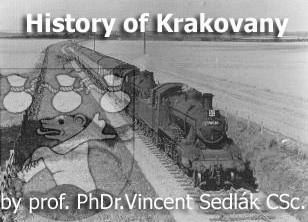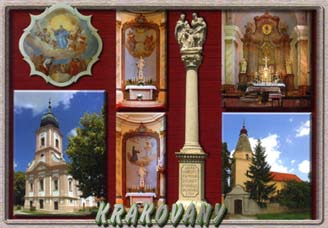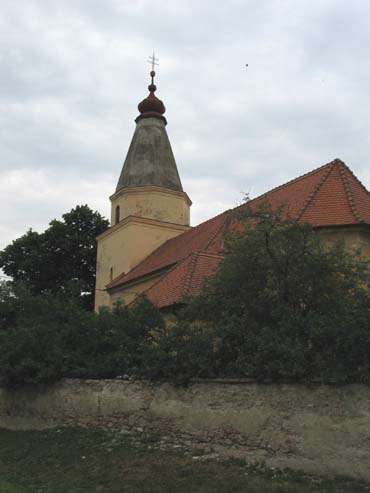|
|
Obec: História Starosta Obecné zastupiteľstvo Zápisnice VZN Formuláre Futbal: A-mužstvo Dorast Žiaci Kultúra: Kultúrny dom Folklór Hobby stretnutia Pamiatky Spolky: Farnosť Poľovníci Červený kríž Hlavná strana |
 Not everything known from the history is written in the resources in easy way. The way historians would just easily interpret it to the readers. Many times, they have to put together a complicated mosaic to get the complete picture. In order to accomplish this, the study of different places and a wide range of material from many different sources are necessary. Then they can get the optimum results. Village monographs are these types of work and the most challenging part of it is finding the remote past of these places. In this outline, the authors aimed for a brief description of the village and its history. From the beginning, the two villages of Krakovany and Straze, that merged,
had their own histories and prehistories. The time of their origin is not
exactly known. The time referred to as prehistory is everything before these
villages had today's names and before our Slavic ancestors lived there. We could
call them Ancient Slovaks; in the same manner as other historical nations call
their historical ancestors.
Both villages had some settlements in the Stone Age. Even though the bones of a mammoth from the earlier Stone Age (2 Mil. - 8500 BC) were found in Straze, the settlement in both villages started in the later Stone Age (5000 – 2800 BC). It continued through the Bronze Age (1900 – 700 BC), the Iron Age (700 – 400 BC) and in its later stage until 100 BC. A very valuable pottery kiln from the 1st century BC is among the precious findings from this period. It was found near the present soccer field in Krakovany. This seems to have been a preferred area for settlement and has the most valuable findings. In Straze, the most valuable findings come from the Earlier Roman Period (200 – 300 AD). They found counts' tombs with multiple silver and gold Roman artifacts. This is the famous Straze Treasure, which once caused so much sensation in the area. Because of its great value, it is a part of the permanent exposition of the National Treasury. At the end of this section, it is necessary to point out that these findings are not the remains of our Slavic ancestors. They belonged to the Celts and the Germans, who at that time lived in this area. The earlier phase of the Slavic settlement (7. – 8. Century AD) is documented by the remains of the Slavic village from the 9th, 11th and 12th centuries, found in Krakovany. There is no reason not to think that the continuation of this village will be found in Straze. This settlement can be ascribed to our oldest Slavic ancestors. The Slavs came to this area during the Great Migration of Nations. They settled in places that were abandoned by the Celts and the Germans before the Hungarians' arrival. After the Hungarian Empire originated, all the land was confiscated by the monarchy. One third remained as property of the king, one third was available for the counties and castles, and one third became a property of the churches. Straze remained as the royal property; it is not known if the village was the
king's private estate or if it was under the county administration. Since we
have no information about Straze being subordinate to any of the castles, we
could assume that the village belonged directly to the king. In the oldest
written document from 1113, this village is mentioned as "Villa Spectaculi", i.e.
"the Sentinel Village". Straze is not considered a monastery property but a
border point of the Zobor properties.
Krakovany first belonged to the Bana castle and then it became the property of the Zobor monastery. The exact date of the transfer is not known. The Zobor Document mentions that the counting and marking of the properties were done in 1113 at the request of Godofred, the Abbot of Zobor. These properties were partially destroyed by the invasion of Otto, the Duke of Moravia (about 1109). Krakovany, Ostrov, Trebatice and Voderady stayed in the Zobor monastery's possession until the bishop of Nitra overtook the properties of this monastery. Voderady later ceased to exist. Krakovany remained as the seat of the administration of these properties. This also explains Krakovany's central position as the parish for Straze, even though it belonged to a different landlord. Straze later became the property of the Oponicky noble family. This ended its function as the sentinel village. A toll was still collected there, but for different reasons. Let us explore the positions of these two villages a little more, considering their names. The name of Straze is clear even in Latin (Villa Spectaculi) and Hungarian (Or). It is not known yet, who raised Straze to its function. We don't know if this happened during the Great Moravia period or after the Hungarian Empire was originated. This problem can be reliably solved only by archaeological research, based on the material findings. From a historical point of view, we can only assume that Straze was the sentinel estate of the old Slovaks. Slovakia came under the Hungarian rule in stages. The proof of one such stage is the village of Vesele. There was a castle in Vesele called "Vegvar". The Hungarians named it after the fact that it was on the border of the Hungarian Empire. Vegvar means a castle at the end, or a border castle. Veg = an end, var = a castle in Hungarian. Because of the wrong pronunciation of the word "veg" as "vig", the name Vesele originated. "Vig" in Hungarian means "happy"; "Vesele" in Slovak means "happy", too. According to this, we can't consider Straze a Hungarian sentinel village.
The name Krakovany is traditionally, but incorrectly explained as being derived from a tree bark. Language scientists have never defined this name as having originated this way. Based on the material gathered so far, of Old Slavic vocabulary, this name could have originated either from a large number of ravens or a settlement on a side branch of a river (Holeska or Ockovsky odpad – Spust, flowing to the Dudvah River). It could also be a settlement on a side of the path going through the river. The last alternative fits Krakovany the best. There are many places named Krakov or Krakovany and all of them have t This is clearly proven by a document issued by Vincent, the Bishop of Nitra in 1258. This document states that the Krakovany area started at the east side of the Dudvah Creek (Dudwag). From there, the border goes west through the groves to the Holeska Creek (Olasca), and then it continues towards another creek called "Sipkovsky potok" (Chypkow). In this way, the area is connected to the other estates of the monastery. Saint Nicholas Church, Krakovany During the medieval period, Straze stopped functioning as a sentinel village. Instead, it changed to a toll collecting place on the way to "Nove mesto nad Vahom". The importance of Straze is confirmed by the fact that this village remained an important intersection after the revision of the roads and the tolls at the beginning of the 15th Century. The toll was still collected there, but some of the paths didn't require payment in Straze. In 1421, the landlord of Straze Oponicky received permission to build either a wooden or stone fortress on a hill. The most probable location of it was at the deviation near the former railroad station. Krakovany also had a fortress in the Middle Ages. It was even older than the one in Straze, but no written documents give any exact dates. We only know that during the conflicts between the Hungarian King and the Moravian Counts in 1405, it was the aim of the attacks. In 1406, King Zikmund credited Count Ctibor for the re-conquest of this fortress. We can only assume its location. It was either located at the place of the former malt house or at the northern end of the village, where the big cellar used to be. The fortress in Krakovany was definitely built because of the central position of the village among the properties of the Nitra diocese. Serf rates from the whole area must have been gathered there. It is very unfortunate, that we don't know the exact location of this fortress. No archival materials of its functioning have been preserved, that would surely contain records of all events in the area. This should be a memento for all of us, not to make the same mistake. We have to preserve all the sights and records for the future generations. A problem of the old church building in Krakovany that collapsed in the 18th century must be archaeologically solved. The church must have been very old, probably built in the 11th century. The building techniques were not on such a level as in the 14th century. That's why the church in Straze, built in the 14th century remained in its original shape until today. The old Krakovany church is preserved on a painting of the new church, where both buildings face one another. We have no information on the number of residents in both villages in the Middle Ages. In 1530, we have information that the Turks burnt Krakovany, Straze and other neighboring villages. The dwellings were restored soon after it happened. In 1531, tax was collected from 12 households, the other 6 were impoverished. There was the toll collector's house, one new house, a house of the shepherd and two abandoned houses. Straze was completely burnt down by the Turks again in 1600. The first house after this disaster was built in 1608. Krakovany had 49 peasant residents in 1585; twenty-four of them lived in quarter dwellings, 19 in one- eighth and 6 in half dwellings. Since then, the number of dwellings had been increasing until some disaster came and destroyed the population. As an example, a cholera epidemic in 1831 killed 314 persons in the Krakovany Register district. The epidemic lasted from August until September 5th. As it usually happens, along with this tragedy, a new life was also born. None of the newborn was among the victims of cholera. Not even in a case where the father died on August 10th and the child was born on August 15th. From the economical point of view, Krakovany was in a better situation than
Straze, because it belonged to a church landlord. The list of duties for this
village was written quite early. The landlord looked after the prosperity of the
village by organizing several different productions.
They brewed beer, made brandy, grew tobacco and hops. We even have a record of a tobacco mill. Home spinning was very developed in the area; the spinners were organized into so-called "factories" ("faktorie" – in Slovak). There were at least 120 – 150 spinners and combers in these "factories". The home production in Krakovany was first a subsidiary of the Cachtice "factory". ← Saint Gal Church, Krakovany-StrazeAfter the growth of this production and subdivision into several "factories", they formed a separate one in Krakovany in 1790. Jozef Prohaska became a chief manager of this newly formed "factory". Even though, it still remained under the supervision of the Cachtice "factory". The number of the workers in this factory (198 + 4) gives us an idea as to the volume of this kind of home production in Krakovany. Considering the number of houses in Krakovany (89) in 1785, it looks like almost everybody was engaged in this production. To get a complete picture of life in these two villages, we must notice other sides of living in that era, both private and social. The social life was not very rich because of the living conditions and the education standard. Everything was kept within that time's stereotype: going to church, market, fair and to some extent, school. The most active social life was during special events. Those were different holidays, family events and village customs throughout the year (e.g. the burning of Morena, to welcome Spring). Later, some higher social activities became a part of the social life. People organized theatres and different cultural events and activities. This area is famous for its lace work and embroidery; the local women have always been admired for their high skills. Brass music has had a long tradition in this area, too. At the end of the last century, but even more so at the turn of the century, the individual folk art and production started to be emphasized. It came up in a more organized social form. The most important cultural activities were greatly influenced by sacred works and activities, primarily of young priests administering in the area. Gradually, very strong associations of amateur theatres were formed. The village brass band was on a level of professional ensembles of that era. Together with the cultural organizations and clubs, various sports clubs started to appear. The sport club in Krakovany, which has been in existence until today, is one of the first officially formed and registered sports clubs in that region. These events resulted into a strong-rooted tradition that still lasts. This was important not only socially, but also economically. It helped to form collective thinking and decision making, entertainment and work skills of the people. These qualities of the local people are evident even today. The village is famous for good grafting results in agriculture, outstanding sports achievements (soccer, ice hockey), and folklore (folklore festivals). But most of all, it's the preservation of the original customs, costumes and spreading their culture among Slovak and foreign visitors. Our wish is to keep the village thriving, widening the cultural, sports and economic activities. That would fulfill the message and the heritage of our predecessors. English Translation: Marcel Hornak and Rasto Gallo |


 his
kind of location. It is important to remark that Straze in the oldest history
period was located only on the south side of Holeska. This was a border between
Krakovany and Straze. Straze inhabitants got to the other side of Holeska by
gradually buying property and building up the area itself.
his
kind of location. It is important to remark that Straze in the oldest history
period was located only on the south side of Holeska. This was a border between
Krakovany and Straze. Straze inhabitants got to the other side of Holeska by
gradually buying property and building up the area itself. 